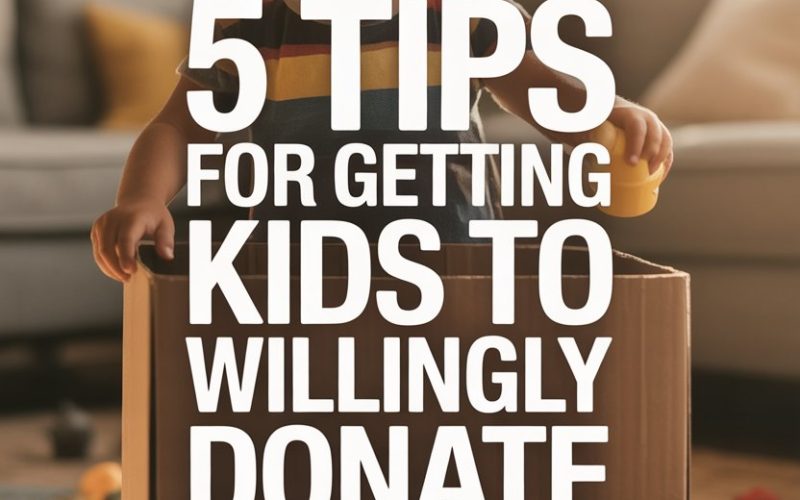Ever tried to pry a well-loved, battered plushie from your child’s arms in the name of “decluttering”?
It’s a bit like asking a squirrel to hand over its winter stash—tears, resistance, and the occasional dramatic declaration of existential despair. Still, the toy mountain must shrink.
Here’s how to get your kids not just to tolerate the toy donation process, but to join in with (dare we say it) enthusiasm.
1. Start With the Why—But Make It Their Why
Kids are natural-born hoarders. From rocks to dried pasta glued to paper, it’s all precious.
The secret sauce for getting them on board? Tapping into what they care about, not just what makes sense to you.
Yes, you could talk about “giving to others” until you’re blue in the face. And occasionally, that lands.
But for most small humans, that’s as motivating as a bowl of plain steamed veg.
Try this: ask questions that help them imagine the joy their toys could bring to other kids.
“What do you think it would feel like if someone gave you a surprise toy?” Or, “Do you remember when you shared your truck at preschool and how happy your friend was?”
Some parents find it helpful to share real stories (with photos, if possible) of kids who have received donations.
Suddenly, it’s not just about getting rid of stuff; it’s about making someone else’s day. Not a bad motivator.
2. Make It a Party, Not a Punishment
No one wants to spend Saturday afternoon being guilt-tripped into parting with their stuff. Turn the process into something you all look forward to—at least, more than you do the annual sock-sorting.
Crank up the music, put out some snacks, and turn sorting into a game.
Challenge your kids: “Can you find three toys you think another kid would love?” or “Pick a soft toy that’s ready for a new adventure.” Offer a silly trophy (say, “The Great Giver” badge) or an extra story at bedtime for enthusiastic participation.
Stickers work wonders, even for the older crowd—no shame in a bit of positive reinforcement.
If your child is motivated by competition, toss in a playful race: who can fill their donation bag first (with your supervision, naturally—no one wants to discover their keys or the family cat in there later).
3. Put Them in Charge (Within Reasonable Limits)
Even pint-sized humans like to feel a sense of power over their environment. The impulse to control what’s “theirs” is strong, and frankly, fair enough.
Hand over the reins: let your child be the boss of their own stuff. You might be itching to clear out the giant plastic monstrosity that sings at 2 am, but resist the urge to pre-select.
Instead, guide them gently—ask them to choose toys they haven’t played with in a while, or ones that could make another child happy.
It helps to set some parameters. For example: “Pick five toys that you’re willing to let go,” or “Let’s fill this one bag.” This keeps the scope manageable without overwhelming them (or you).
There’s a bonus here: kids who feel respected in the process are much more likely to engage willingly. Child development experts consistently say that autonomy breeds cooperation.
And if your child clings to a toy you absolutely can’t stand? Take a deep breath. One or two “keepers” won’t sink the ship.
4. Make Giving Tangible and Immediate
“Out of sight, out of mind” works for old leftovers, not toys with faces and feelings (well, according to your child, anyway). The more concrete and immediate the act of giving, the better.
Skip the black bin bag in the boot of your car for weeks. Instead, go with your child to the donation centre, or let them hand over their toys to a charity worker or community group.
Some parents even arrange a quick visit to a local shelter (call ahead—it’s not always possible, but ask).
Other options: take photos of the toys being packed up, write a little note together, or draw a picture to include with the donation. This helps children process the transition—it feels like an event, not a loss.
If your child is into arts and crafts, decorate the donation box together. You might be surprised how much pride a child takes in a box festooned with glitter and googly eyes.
5. Celebrate, Don’t Just Move On
You did it. The toys have left the building. Before you skip off to enjoy that sweet extra floor space, take a moment to mark the occasion.
Celebrate your child’s generosity—yes, even if the donation pile was a bit smaller than you dreamed. Make a big deal out of it.
“You made another kid so happy!” works just as well as “I’m so proud of you!” Some families like to keep a scrapbook (digital or old-school) of their giving moments.
A small treat or a family movie night can reinforce that donating isn’t just a chore, it’s something special. Not a bribe, mind you—just a way to acknowledge effort and encourage a positive association.
And if your child seems a little low after saying goodbye to a beloved toy, that’s fine. Feelings are allowed.
Offer hugs, reassurance, or even a silly story about where the toy is “off to next.” (Spoiler: it’s probably not starting a new life as a secret agent, but your child doesn’t need to know that.)
When Kids Surprise You (And Themselves)
Every parent dreams of a child who skips into the room declaring, “I’ve decided to share all my toys with children in need!” That moment might take years—or happen the week after you gave up hope.
The process is what counts.
Giving is a learned skill, not an innate talent.
With patience, encouragement, and a dash of creativity, you’re not just clearing clutter; you’re raising kids who know the joy of generosity.
And who knows? You might even find a few surprises at the bottom of the toy bin for yourself. (That missing remote, perhaps? Stranger things have happened.)
Ready for calmer cupboards?
Your child’s giving journey starts at home—and it just might be more heartwarming than you expect.





